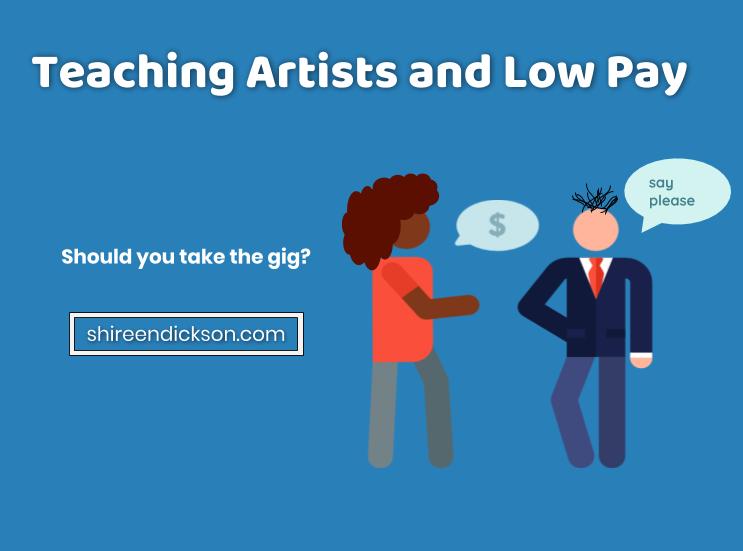Teaching artist pay ranges….greatly.
Some programs offer a minimum of dollars for a maximum of headache; others offer premiums on top of excellent pay for things like travel, special appearances, and trainings. Obviously, experience dictates pay, but at least in NYC it is getting increasingly more difficult to find those $85/hr plus gigs if you don’t create them yourself.
In my experience, the programs that care about and have seen the results of effective teaching artistry pay well to retain great artists.
And the programs whose EDs are still working out the true organizational mission, or placed one wrong person in a program management position, are the ones that don’t understand why they have regularly absent staff, kids who are still unruly and disorganized in March, and documentation that funders look at askance.
But I digress.
Low Teaching Artist Pay Sucks – So Why’d You Take the Gig?
You’re young.
In NYC there is always a fresh crop of budding artists supplementing their aspirations for mass appeal with a random teaching gig. There are always dance/art/music ed majors itching to test their poppin’ fresh standards-based curricula. And do it at a rock-bottom price. (Ah, artists.)
You’re old.
Maybe you’re in the other boat, where the lure of a consistent, long-term gig overrides the hassles that come with a low-paying gig, and you’re so experienced that you can teach your classes without getting mired in the other crap. Maybe you’re saving for retirement in your middle age or are on another hustle.
You’re expendable.
If a hiring organization only expects you to be a placeholder, or room monitor, or checked-off box on their grant report, then you will be paid as such. You will be seen as an expendable commodity, rather than an asset.
You can “complain” about nonsensical time sheet procedures, behavior consequences that aren’t enforced, promised materials never materializing. You can even offer suggestions — AND offer to implement them. Probably won’t change anything. The culture of the organization has already devalued the artistic experience as a priority.
You just didn’t know!
You can use this handy ideal teaching artist pay rate calculator to give you a sense of what you should be earning. It’s a cute tool, useful if this is the category you fall into.
You got low-pay offer? Consider these things.
I just agreed to do a series of classes at a cafe half a block from my apartment on a donation basis after a quick run through the checklist below.
Would I do that if I had to travel from Brooklyn to Jersey City for an hour every week? No. I can’t pay for gas with hope.
See the considerations, and examples of my rationales, below:
LOW-PAYING GIG CHECKLIST:
Quickly Determine Whether
To Take The Gig – or Not!
CONSIDERATION
MY RATIONALE
How far you have to travel and by what means
The cafe is a five minute walk from door-to-door
How early you have to get up/arrive at location
Not a concern: class set for afternoon
How involved you have to be in the prep (from trainings and meetings w/ teachers or site directors, to setting up rooms and materials)
I created a brief text document and logo listing two class descriptions and emailed it for her to advertise through her channels
Owner agreed to space being set up beforehand
Is the learning space ideal?
Not in the least – it’s small and cramped. But that gives flexibility in what/how I teach (less work, less traditional structure) and a creative boost (how can I use all cafe spaces, especially with the children’s class?)
What supplemental materials you are required to submit (like lesson plans, documentation, and reports)
I don’t have to do anything like that
The additional time that a culminating event may necessitate
|
There’s no culminating (as of now) |
The efficiency of hiring organization’s payment procedures
Seamless. We decided on a donation-based class; I keep whatever is contributed
Are you working with a captive or self-selected audience? Are they “voting with their feet?”
Audience is all of the above. They will be there to have fun, but there are no hard deliverables.
Are there any other benefits that sponsor organizations can offer, like rehearsal or storage space, accommodating absences or schedule adjustments for tours/travel, etc?
I travel at least once a month so I can schedule classes irregularly.
What personal life factors may affect your performance on the job?
I always have to consider the costs and scheduling of childcare, and how that complicates logistics. I can bring my toddler along if needed.
We were able to negotiate all of that including me asking the pertinent questions in a minute, partly because I’ve been through the process so many times.
It is always your right (and responsibility) to request time to contemplate taking the gig, to make sure that you can provide the best services under the circumstances.
These are the things I consider (and you should too) when accepting a teaching artist residency or workshop rate.
Incidentally, the list also generally important things to consider before accepting ANY residency or teaching opportunity. But I know at least for me, the more I feel like my skills are fairly compensated, the more willing I am to increase my scope of responsibility beyond showing up ready to teach and rolling out shortly after I’m done.
[Sassy_Social_Share align=”center” title=”Share and/or follow, if you please!”]
I’m excited about what you’re writing
I truly do want to hear from you! I appreciate any opportunity to pontificate on these subjects. Or, if I can help in any way, let me know.
Your nameEmail AddressMessageSend message

No responses yet